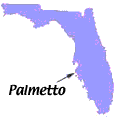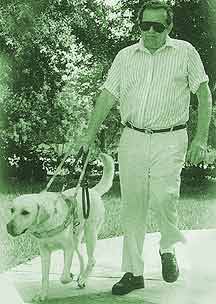 |
 |
 |
 Related Stories: Traveling Disabled Traveling with Pets |
 |
 |
 |
 Stephen Brown, a Fort Myers resident, loves the beach. And since graduating from a prestigious Palmetto school in 1992, his auditory, tactile, and olfactory senses have delighted in visiting Florida beaches. Stephen Brown is blind.
Stephen Brown, a Fort Myers resident, loves the beach. And since graduating from a prestigious Palmetto school in 1992, his auditory, tactile, and olfactory senses have delighted in visiting Florida beaches. Stephen Brown is blind.A graduate of Southeastern Guide Dogs, Inc., Brown and his canine eyes "Ace" have accomplished most everything the sighted have accomplished. There is just one area where Ace falls short.
"He won't get into the car when I'm behind the wheel," Brown says, his sharp sense of humor catching me more than once.
Southeastern Guide Dogs, Inc., is located on 24 acres in Palmetto. Their sole purpose is to train guide dogs and provide them to the blind at no cost to the recipient. In addition to housing a breeding kennel, the program has an on-site kennels for dogs first entering the program and one for adults to be trained in their usage of the dogs.
The Freedom Walk is a unique series of paved sidewalks and training obstacles created to introduce guide dogs to living in cities. For several years the Palmetto grounds provided not only top-notch training, but lush tranquil surroundings in which to train. However, many of these animals would then return with their masters to live or work in large cities. The dogs were sometimes spooked by city noises like sirens, blaring horns, and loud engines. These dogs needed training in proper reaction to large crowds on city sidewalks. Utilization of public transportation is taught as well.
 Kimberly Marlow, Development Director of Southeastern Guide Dogs, Inc. says, "The Freedom Walk is serving as a great training tool for our students. The walk provides an area which mimics real life situations, but provides a comfortable environment for those in training."
Kimberly Marlow, Development Director of Southeastern Guide Dogs, Inc. says, "The Freedom Walk is serving as a great training tool for our students. The walk provides an area which mimics real life situations, but provides a comfortable environment for those in training."A concept of the graduate council at Southeastern, of which Stephen Brown is a member, the Freedom Walk was developed in five phases.
Phase One was laid out in a lazy figure eight with a gazebo. Phase Two runs in front of the training facility and includes wooden bridges to signify changes in underfooting. Phase Three implements the challenge of distraction, as there are often up to thirty dogs running in this area at one time. Phase Four utilizes the dormitory buildings.
Phase Five, the most vital phase in teaching "city living" to the guide dogs includes a circular walk, railroad crossing, fountain, cobblestone walkways, wooden bridges, street lights, and a paved area with a complicated layout. It is adjacent to an area designed to represent a bus stop. Along the walkways are areas where the instructors frequently place parking meters, phone booths, mailboxes, bike racks, and other objects found on city streets.
A costly endeavor, fundraising was necessary in implementing this enormous project.
"To raise the funds necessary for this project, we offered bricks for $100 and asked for sponsorship of other items such as park benches, street lights, and the fountain," Ms. Marlow states.
Labrador Retrievers are the primary breed used at Southeastern, although Australian Shepherds, German Shepherds, and Collies are occasionally used as well. The initial training is provided by puppy trainers who host the dogs in their homes for one year, teaching a variety of simple commands. At twelve months the dogs enter the program site and are paired with one trainer with whom they stay through graduation.
The Freedom Walk has proven to be very challenging and rewarding for students and trainers at Southeastern Guide Dogs, Inc. This state-of-the-art concept has made Palmetto, Florida a unique location on the map, and has allowed many graduates to return to their city dwellings or offices well-equipped in handling obstacles encountered on a daily basis.